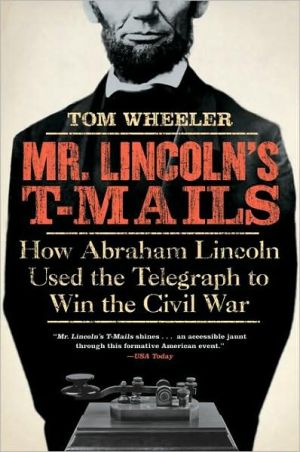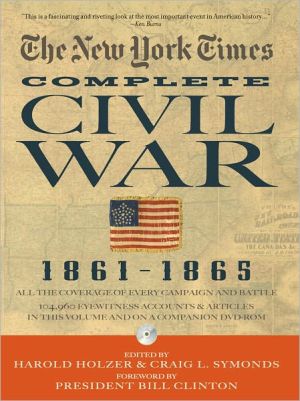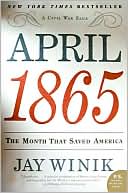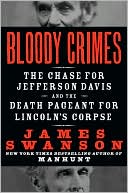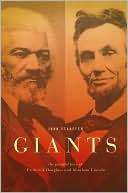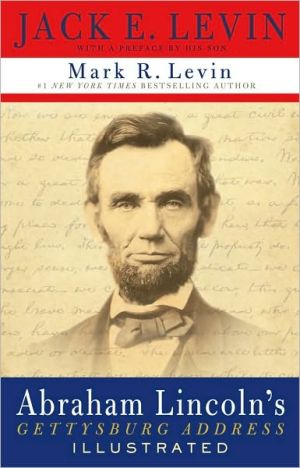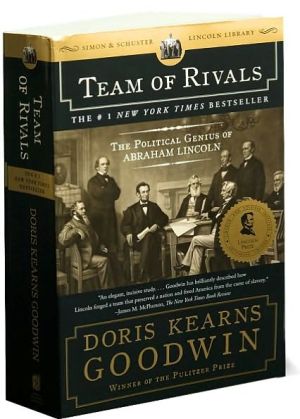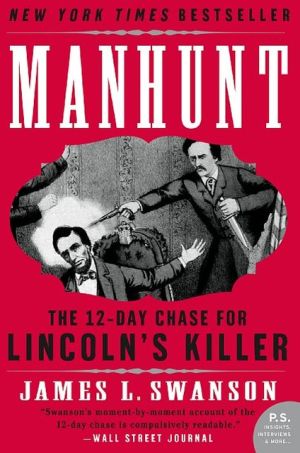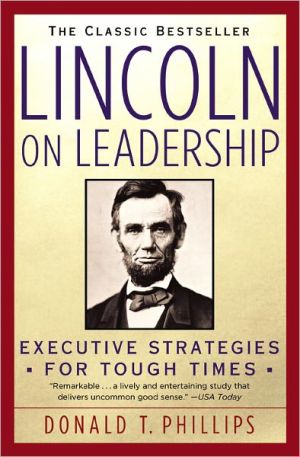Mr. Lincoln's T-Mails: How Abraham Lincoln Used the Telegraph to Win the Civil War
Abraham Lincoln's two great legacies to history—his extraordinary power as a writer and his leadership during the Civil War—come together in this close study of the President's use of the telegraph. Invented less than two decades before he entered office, the telegraph came into its own during the Civil War. In a jewel–box of historical writing, Wheeler captures Lincoln as he adapted his folksy rhetorical style to the telegraph, creating an intimate bond with his generals that would...
Search in google:
The Civil War was the first "modern war." Because of the rapid changes in American society, Abraham Lincoln became president of a divided United States during a period of technological and social revolution. Among the many modern marvels that gave the North an advantage was the telegraph, which Lincoln used to stay connected to the forces in the field in almost real time. No leader in history had ever possessed such a powerful tool to gain control over a fractious situation. An eager student of technology, Lincoln (the only president to hold a patent) had to learn to use the power of electronic messages. Without precedent to guide him, Lincoln began by reading the telegraph traffic among his generals. Then he used the telegraph to supplement his preferred form of communication - meetings and letters. He did not replace those face-to-face interactions. Through this experience, Lincoln crafted the best way to guide, reprimand, praise, reward, and encourage his commanders in the field. Mr. Lincoln's T-Mails tells a big story within a small compass. By paying close attention to Lincoln's "lightning messages," we see a great leader adapt to a new medium. No reader of this work of history will be able to miss the contemporary parallels. Watching Lincoln carefully word his messages - and follow up on those words with the right actions - offers a striking example for those who spend their days tapping out notes on computers and BlackBerrys. An elegant work of history, Mr. Lincoln's T-Mails is an instructive example of timeless leadership lessons. USA Today “Mr. Lincoln’s T-Mails is an accessible jaunt through this formative American event.”
Mr. Lincoln's T-Mails\ The Untold Story of How Abraham Lincoln Used the Telegraph to Win the Civil War \ \ By Tom Wheeler \ HarperCollins Publishers, Inc.\ Copyright © 2006 Tom Wheeler\ All right reserved.\ ISBN: 006112978X \ \ \ Chapter One\ Electronic Leadership\ What became of our forces which held the bridge till twenty minutes ago, as you say?" the president of the United States telegraphed a Union army colonel during the 1862 Battle of Second Manassas (Bull Run).\ For the second time in 13 months the Confederate army was thrashing Lincoln's troops on the ground around Manassas, Virginia, just outside the Federal capital. During the first battle the president followed the lead of his military advisors and patiently awaited the final news from the battlefield. It was different the second time around. Abraham Lincoln was fully engaged, making inquiries and receiving reports from the battlefield. The tool that allowed the president to become so engaged was the telegraph.\ Like most of the people it represented, the U.S. government was slow in awakening to the opportunity presented by the telegraph. When Lincoln took office, if a government agency wished to send a telegram an employee was sent to queue up at the central telegraph office. At the outbreak of the war even an agency as essential as the War Department was not connected to the telegraph network.\ Like his countrymen and his government, Abraham Lincoln had to learn how to use the telegraph. Lincoln's challenge, of course, was that hislearning curve occurred amidst a military conflict to determine the fate of the national union.\ The First Battle of Manassas (Bull Run) occurred four months into the Lincoln presidency. In the slightly more than a year between the first battle and the rematch on the same ground, Abraham Lincoln discovered the power of the telegraph to project his voice, as well as to extend his eyes and ears. As he grew in his role as a national leader, Lincoln simultaneously progressed in how he applied what he sometimes called "lightning messages" to extend that leadership.\ First Manassas (Bull Run) was the first major battle of the Civil War. As the newspaper headlines cried "Forward to Richmond!" the new chief executive pushed his generals to take action. The route to the Confederate capital of Richmond ran through Manassas, Virginia, approximately 30 miles outside of Washington, a railroad junction at the mouth of a key pass through the Blue Ridge Mountains. There, on the plain beside a small, steep-sided stream named Bull Run, General Irvin McDowell planned to attack the Rebels, while another Union force on the opposite side of the Blue Ridge kept the Rebels in that area bottled up and out of the action.\ The Union army's plan was based on the old realities of horse-mounted messengers and plodding troop marches. The new reality was an expanded battlefield made possible by two new civilian technologies: speedy telegraph messages and troops transported by rail. The application of these two technologies determined the outcome of the battle.\ The telegraph summoned transport trains and Rebel troops to an historic event. It was the first time in the history of warfare that troops would be transported directly to the field of battle by train. After giving the slip to the Union force that was supposed to keep them caged, Confederate soldiers were loaded into boxcars. The troops moved faster than any army in history; one moment they were too far from the action to be decisive, the next moment they were on the battlefield. Their arrival turned the tide on July 21, 1861.\ Lincoln and the other national leaders in Washington could hear the cannons' thunder on the horizon. Yet there was an almost unreal lack of involvement with the first engagement at Manassas. General-in-Chief Winfield Scott, hero of the Mexican War but now fighting a new war by the same old rules, was so accepting of the tradition of being unable to communicate rapidly with the front that he took a nap during the battle. The president had to awaken him as the battle raged.\ Prior to First Manassas, Andrew Carnegie, who began his career as a telegraph operator for the Pennsylvania Railroad, was placed in charge of extending the telegraph lines across the Potomac into occupied Rebel territory. By the time of the battle, however, the line reached only as far as Fairfax Court House, about 10 miles from Bull Run. In a hybrid of the old and new, messengers galloped from the battlefield to the end of the telegraph line carrying news. "Lincoln hardly left his seat in our office and waited with deep anxiety for each succeeding despatch," recorded the telegraph office manager.*\ Initial reports were of a Union victory. No doubt relieved, the president went for a stress-reducing carriage ride. When he returned half an hour later, the news was dramatically different. The rail-transported Rebel troops had arrived in the nick of time and routed the Union force. Lincoln's army was fleeing back to Washington in disarray. There was fear for the safety of the capital.\ Thirteen months later, when the armies clashed again along Bull Run, it was a decidedly different Abraham Lincoln who took up residence in the War Department telegraph office. The telegraph office had become his Situation Room, where the president not only monitored events through incoming messages but also initiated communications directly to the field. Lincoln became so involved with the flow of information during Second Manassas that he did not return to the White House for sleep, preferring instead a cot that had been set up in the telegraph office.\ Unable to communicate with his key generals because the Rebel movement had cut their telegraph lines, Lincoln opened a telegraphic dialog with a subordinate officer that continued over the next several days. The telegrams between Lincoln and Colonel Herman Haupt were at one point the national leadership's best source of information. It was another historic moment: a national leader electronically engaged in monitoring the activities of a battle at which he was not present.\ Throughout the entire history of armed conflict, the ability to have a virtually instantaneous exchange between a national leader at the seat of government . . .\ \ \ Continues... \ \ \ \ Excerpted from Mr. Lincoln's T-Mails by Tom Wheeler Copyright © 2006 by Tom Wheeler. Excerpted by permission.\ All rights reserved. No part of this excerpt may be reproduced or reprinted without permission in writing from the publisher.\ Excerpts are provided by Dial-A-Book Inc. solely for the personal use of visitors to this web site. \ \
Acknowledgments ixIntroduction xiiiElectronic Leadership 1Messages by Lightning 17The Telegraph Creates a President 31Electronic Breakout 46After the Breakout 68New Electronic Challenges 93Commanding Through the Inbox 110Even with Technology, It's All about People 130Building the Modern Leadership Model 142The Last Lap 164"Now He Belongs to the Ages" 179Notes 187Bibliography 207Index 215
\ Ken Burns"Wheeler [reveals] our now god-like 16th President to be an astute manipulator of modern technology."\ \ \ \ \ Michael Beschloss"A fascinating, succinct and original history of how a great President used cutting-edge technology to save his country."\ \ \ Harold Holzer"Just when we might think nothing new can be written about Lincoln comes Wheeler’s captivating take on the Lincoln legacy."\ \ \ \ \ USA Today"Mr. Lincoln’s T-Mails is an accessible jaunt through this formative American event."\ \ \ \ \ Bloomberg NewsThe book thunders along, following the "messages of lightning" down the wires….The writing is focused and lean.\ \ \ \ \ Washington Post Book World". . . an original take on Lincoln’s presidency"\ \ \ \ \ USA Today“Mr. Lincoln’s T-Mails is an accessible jaunt through this formative American event.”\ \ \ \ \ Washington Post Book World“. . . an original take on Lincoln’s presidency”\ \ \ \ \ Bloomberg NewsThe book thunders along, following the “messages of lightning” down the wires….The writing is focused and lean.\ \
